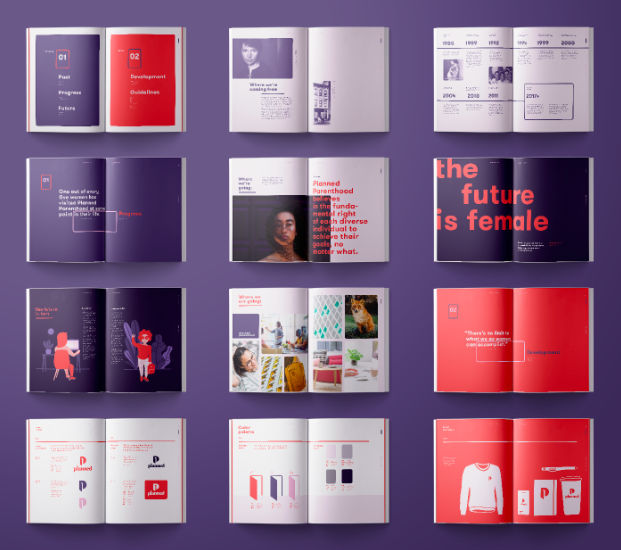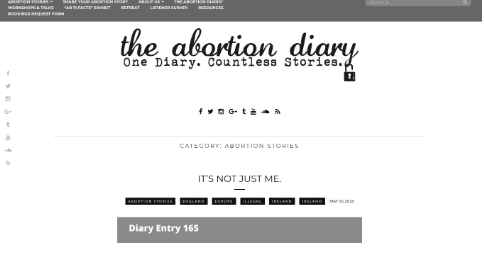2 May 2019
Sophia Valdez, Alyssa Medina, Jenna Lewis, Alyssa Keating, Norma Anaya, Christine Mora, and Amanda Vick
Planned Parenthood and Reproductive Rights:
The controversy regarding Planned Parenthood
Roe v. Wade, passed in 1973, was a landmark case that ensured that women’s rights to abortion access were a constitutional right. Despite its passage nearly 50 years ago, women all over the country are still facing restricted and unequal access to the safe medical care they need. This inequality is perpetuated by limited media representations that have yet to show the full spectrum of women’s health issues and the ways that Planned Parenthood meets those needs.
Our current administration is in the process of trying to fully defund Planned Parenthood, even though the services they provide are not solely abortion-related. Misconceptions about Planned Parenthood’s mission and core values can be attributed to unfair–and often one-sided–media representation. While there are many facets to the abortion debate, it is rare to observe neutral opinions about women’s reproductive rights in media. People are generally expected to choose between two sides: pro-life, a more conservative belief, and pro-choice, a more liberal one. Needless to say, these discussions we have regarding abortion are now more common than ever as its depiction in media increases and society’s views, as a whole, begin to shift.
The irony of the pro-life and pro-choice debate is that those with more conservative views tend to view Planned Parenthood unfavorably, even though it provides more comprehensive and affordable health care that would essentially increase one’s quality of life. Conservative media outlets often exclude this information and instead focus on the moral aspects of abortion. More liberal and mainstream outlets report on reproductive rights as a whole, and how they tend to intersect with other social problems. Many of these same outlets are working on reducing the negative stigma surrounding Planned Parenthood by speaking on its wide array of services.
Planned Parenthood provides annual wellness checks, general exams, free contraceptives and even services for people who identify as male or gender non-conforming.This should be better represented in the media so that the public is aware of how much marginalized groups and low-income communities depend on these services.
The Trump administration and other outspoken pro-life entities are clearly seeking to dismantle Planned Parenthood by reducing and eventually eliminating all federal funding. We seek to inform the public about Planned Parenthood’s significance to underrepresented and underprivileged communities, raise awareness of its services offered and eventually minimize its negative stigma.
By Sophia Valdez

The Politics of the Fight
As hundreds of thousands of women utilize Planned Parenthood for their many services, the Trump administration is attempting to persuade Congress to pass a defunding bill; which would essentially rob 2.4 million people a year of necessary birth control, STD and cancer screenings and much more. Many of the U.S states have individually filed lawsuits against the Trump administration as a form of protest against the new “gag rule” and the defunding bill. The Trump administration has shown time and time again of their lack of care towards women and reproductive health. Planned parenthood is supported by many Americans, including 48% of Trump supporters and plans to stand defiantly against political bullies.
Donald Trump has made it his mission to take away funding from planned parenthood. He is completely against abortions, and affordable reproductive health care, deeming it a “luxury” he has now attempted to implement the “Gag Rule.” Which means that doctors in the Title X program are banned from telling women about preventative care and how to access abortion. It also prevents patients from getting full and accurate information towards birth control.
By Jenna Lewis
References
The New York Times: California Sues Trump Administration to Block Restrictions to Family Planning Program.
The Washington Post: Defunding Planned Parenthood Would Lead to Thousands of More Births, CBO Says.
Planned Parenthood Action Fund: How Federal Funding Works at Planned Parenthood
Media Representation of Planned Parenthood

“Planned” by Dana Van Etten is licensed under CC BY-NC-ND 4.0
There has been more talk about abortion and women health care in the media. It gives us an insight of what is out there regarding resources because now that celebrities, tv shows, podcast, and movies have made it more of an acceptable conversation than before. There has been a shift in the diverse conversation and vary opinions when it comes to planned parenthood because now the topic has become a norm versus an inhumane perspective. In addition to that, majority of the conversation regarding women’s health care and reproduction is dominated by men.
By Norma Anaya
NPR: Abortion Plots On Television ‘Becoming More Diverse And Accurate’
People’s World: Sex, politics, and film: Why Planned Parenthood has gone Hollywood
Daily Beast: Men Rule Media Coverage of Women’s News
Mic: Men Dominate Media Coverage of Reproductive Rights, According to a New Study
The Misconception of Planned Parenthood

“Planned” by Dana Van Etten is licensed under CC BY-NC-ND 4.0
There is a misconception of Planned Parenthood, that the only services that they provide are abortions. The reality is that the services provide is STD testing and treatment, birth control, cancer screening, and prevention, hormone therapy, infertility services, and general health care, etc. In addition to that, they work with low-income families and they work with people that have other forms of health insurance. Their mission is to ensure that people are the health care they need, the clinics are not just open to women but to men and the LGBTQ+ community. It is also a safe space where the community can feel that their decisions are being supported and ensuring that they are receiving the right information.
By Norma Anaya
USA TODAY:
With abortion services in the crosshairs, Planned Parenthood is reshaping its image. Will it work?
CNN: Planned Parenthood: Fast facts and revealing numbers
Rewire: Abortion Remains ‘Our Core Mission,’ Says Planned Parenthood President
How You Can Take Action
Call Your Representative: Call Now
Use the form in the link to call your U.S representative and declare your stance with Planned Parenthood. Fill out the form with your phone number and zip code so a local representative can give you a call, the website also offers a script that highlights concerns about the legislation and Planned Parenthood.
Support Those Doing the Work: #StandWithPP
Four ways you can support those in the fight for PP and reproductive rights:
- Click the hashtag above and share the video of Title X provided on the website
- On the same website sign the brief! PP is suing the Trump Administration and needs signatures to support planned parenthood patients
- Remind Planned Parenthood that they are not alone in this fight! Engage in peaceful protests, educate others, change your profile photo and use the hashtag #ProtectX to show your support. Here Is Planned Parenthood’s digital swag kit to help you show your support.
Planned Parenthood Northern California Action Fund: Donate Here
- PROTECTS programs that keep the services of Planned Parenthood health centers affordable, like family PACT
- INFORMS our community about the importance of protecting reproductive rights
- ELECTS candidates who care about reproductive healthcare, comprehensive reproductive and sexual health education, and your right to make your own medical decisions
Protect x: I stand with Planned Parenthood
By Jenna Lewis
MEDIA ANALYSIS
Sex Education– The Abortion Clinic Episode
Real, accurate, and raw portrayals of what teens go through when trying to navigate through the maze of their own sexuality is just not seen in mainstream media. Netflix, however, brought this topic out of the shadows and into the light of pop culture. The Netflix original show, Sex Education, touches on a variety of taboo subjects regarding teenage dynamics with sexuality. Of the most hard hitting episodes sits episode 3 which touches on the character Maeve, portrayed by Emma Mackey, and her abortion. Abortion’s are a touchy and taboo subject, and like all hard and divided subjects, the accurate portrayal of them is often blurred and misconstrued. However, the show Sex Education made it a mission to create an accurate depiction of what abortion clinics are for most women.
Maeve, early on into the episode, visits the clinic and is immediately treated with respect and care by the physicians and employees at the clinic. She is guided on a full range of contraceptive choices including abortion. Now, in mainstream media abortion clinics are often painted as a pushy, rude, and insensitive experience, but that is not usually the case. As seen in the show, the physicians treated Maeve respectfully, showing her all the options without bias, and accepting of her decision to terminate the pregnancy. This is the key takeaway from this episode–abortion clinics are not meant to push abortions, they are meant to provide a full range of safe healthcare to women.
The show also portrays the procedure accurately as well. For many women abortions are not terrible procedure, both emotionally and physically. The procedure takes minutes, and often does not require anesthesia. The idea that abortions are an archaic procedure that requires anesthesia and a long recovery period are used as propaganda against the procedure and the clinics. While to some abortions are emotionally difficult experiences, clinics often have support systems put in place for the emotions that can come with the procedure, other do not view it as emotionally crippling as it is often portrayed. I believe the show was trying to show how visits to abortion clinics and abortions themselves do not have to be overly dramatic and mystifying.
The show takes on a third wave, liberal feminist standpoint. Sex Education shows how women’s reproductive rights should not be stigmatized. The show wants to bring light to the basic human rights that allow people access to healthcare, and this includes reproductive care. The show in and of itself is utilizing media and trends to promote this idea, and this utilization of media and technology aligns with that of a third wave feminist. Overall, the show looks to show people of all ages just how pivotal sexual education and health can be, and tries to show accurate portrayals of all sorts of taboo and stigmatized subjects, including abortion.
The Abortion Diaries Podcast
By Christine Mora

“The Abortion Diary” is a raw, real and may be triggering to some. This is a podcast that tells the story of real women and their experiences of going through and abortion and how they felt. This podcast has many different entries from all different women and different eras of when they get there abortion some even got back alley abortions and still are here to tell their story.
When you listen to this podcast and different stories a lot of women mention the different waves of feminism. One particular entry that focused on a wave of feminism is entry number 164 called Sue P, this entry is by Sue P talking about her experience while getting an abortion in New York in 1965 before it was legal to get an abortion she explains how while she was getting the abortion she had woken up and how she was afraid she might die.
This podcast is a great podcast to listen to if you want to learn more about abortions and here what a real experience is.
By Alyssa Medina

2 comments for “Reproductive Rights”